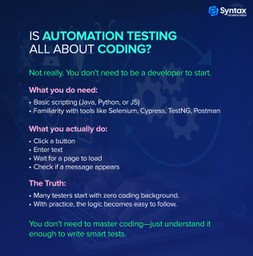It’s a question that many QA professionals and tech beginners find themselves asking—“Is it really worth preparing for automation testing?”
Especially for those working in manual testing or just entering the tech space, the doubt is understandable. Learning a new skill feels like a big leap. Coding seems intimidating. And with so much online content, it’s easy to feel lost.
But take a step back and look at what’s actually happening in the industry—and the answer becomes clearer.

The Shift Is Real: From Manual to Automation
Walk into any modern tech company today, and chances are, the QA team isn’t just clicking through test cases manually. They’re writing automation scripts, integrating test cases into CI/CD pipelines, and using tools like Selenium, Postman, and Cypress.
This shift isn’t just a trend—it’s a direct response to faster product releases and higher quality standards. Manual testing is still valuable, but automation is quickly becoming the standard for anything repetitive, large-scale, or regression-related.
According to the World Quality Report 2023, over 75% of organizations are actively investing in automation testing. That says a lot.
What Makes Automation Testing a Smart Career Move?
1. Better Pay and Career Growth
Automation testers typically earn more than manual testers, and they’re often first in line for advanced roles like SDET (Software Development Engineer in Test) or QA Automation Lead. These roles come with more responsibility, but also more opportunities to grow and specialize.
2. More Opportunities Across Industries
E-commerce, fintech, healthcare, gaming, edtech—almost every digital product needs automated testing. It’s not limited to just IT companies anymore. Automation testers are in demand across the board.
3. Stronger Job Security
With more companies embracing Agile and DevOps models, automation skills have become essential. Testers who understand both manual and automation are seen as flexible, future-ready professionals—and that makes them harder to replace.
4. Faster Feedback and Better Collaboration
Automation testers often work closely with developers, product managers, and DevOps teams. Writing test scripts that run instantly after each code push helps catch bugs faster. This makes testers an important part of the release pipeline—not just someone who comes in at the end.
5. Hands-On Involvement in Modern Tech Practices
Automation testing opens the door to working with CI/CD, Docker, Cloud Testing, API Testing, and AI-powered testing tools. It helps testers stay relevant in fast-changing tech environments.
6. Pathway to Transition Into Development or DevOps
Many automation testers eventually explore roles in DevOps, backend development, or even site reliability engineering. Since they already work closely with code, infrastructure, and workflows, the transition is smoother compared to those coming from pure manual backgrounds.
How Should a Beginner Prepare?
Preparation doesn’t have to be overwhelming. Here’s a simple path to get started:
- Learn the basics of manual testing (test case writing, bug reporting, STLC/SDLC)
- Choose a language (start with Java or Python)
- Learn Selenium or Cypress for browser automation
- Practice API testing with Postman or RestAssured
- Explore test frameworks like TestNG or JUnit
- Learn the basics of Git and CI tools like Jenkins
- Build small projects or contribute to open-source test suites
Final Thoughts
The demand for skilled automation testers isn’t just a trend—it’s a clear shift in how modern software is built and delivered. Preparing for automation testing isn’t just “worth it”—it’s quickly becoming essential for anyone who wants to grow, stay relevant, and build a long-term career in tech.
And the good news? You don’t have to figure it all out alone.
If you’re looking for structured guidance, real-world projects, and hands-on support, consider enrolling in the SDET course by Syntax Technologies. It’s beginner-friendly, practical, and designed to take you from zero to job-ready—step by step.

